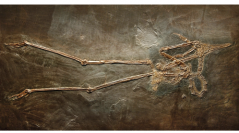

 Comptes Rendus Palevol
13 (1) - Pages 9-18
Comptes Rendus Palevol
13 (1) - Pages 9-18The Early Eocene Juncitarsus was described as one of the earliest fossil flamingos, and played a critical role in the hypothesis of a charadriiform origin of Phoenicopteriformes. It has been noted that phoenicopteriform affinities of Juncitarsus conflict with the recently proposed sister group relationship between flamingos and the morphologically very divergent grebes (Podicipediformes), but a detailed assessment of the evolutionary significance of Juncitarsus in light of this new hypothesis has not yet been performed. Here, the affinities of Juncitarsus are reviewed, and its position as sister group of the clade (Phoenicopteriformes + Podicipediformes) is affirmed. The osteology of Juncitarsus suggests that swimming adaptations evolved in the stem lineage of this latter clade after the divergence of Juncitarsus. Charadriiformes remain among the candidate taxa for the closest extant relatives of flamingos and grebes, but more data are needed for well-supported phylogenetic hypotheses.
Phoenicopteriformes, Podicipediformes, Mirandornithes, Phylogeny, Juncitarsidae